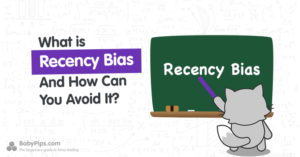“Recency bias” is a buzzword that gets tossed around frequently in trading circles, but what does it actually mean?
Put simply, recency bias is the tendency for traders to focus exclusively on recent events while ignoring older data that may be just as relevant (or even more so).
This bias undermines a trader’s market analysis by clouding judgment and compromising decision-making abilities.
In forex markets, recency bias typically shows up when traders fixate on their latest trades and lose perspective on their overall performance.
Consider a fundamental trader who overreacts to a just-released economic report while neglecting the broader macroeconomic context.
Or think about a technical trader who gives excessive weight to recent candlestick patterns, causing them to miss important long-term trends.
The psychological dimension is equally important. Picture two traders:
Mike just closed 3 winning trades and has an overall record of 4 wins, 6 losses. His account is up 1% for the year.
John just experienced 3 consecutive losses. His record shows 8 wins, 7 losses, and his account is up 5% year-to-date.
Mike is celebrating his hot streak while John feels discouraged.
Looking at the full picture reveals that John is actually performing better. He has a superior win rate and significantly higher returns than Mike.
When Mike and John focus too heavily on recent results, they risk falling victim to recency bias, which can sabotage future trading decisions.
Mike might ignore red flags and rush into trades recklessly, while John could abandon his risk management protocols and start overtrading out of frustration. Neither outcome is desirable.
Do you recognize yourself in these scenarios?
If so, here are strategies to combat recency bias:
1. Maintain a comprehensive trading journal
As emphasized in the School of Pipsology, a detailed trading journal functions like having a personal coach monitoring your every decision.
Tracking your progress alongside successful and failed trades provides a comprehensive view of your trading performance and prevents you from obsessing over recent results.
2. Document your trading strategy
Consider creating a checklist outlining all conditions that must be satisfied before entering a position.
This approach reduces the influence of emotions – whether it’s overconfidence from recent wins or hesitation following losses – and keeps you focused on executing your plan.
3. Engage in deliberate practice
Deliberate practice reinforces why you developed your trading strategy and validates its effectiveness.
This practice also helps you stay aligned with prevailing market themes and enables you to modify your approach when conditions change.
This dual benefit allows you to maintain perspective while simultaneously evaluating your performance.
4. Track your emotional state
Monitoring your emotions is crucial for avoiding recency bias. When you sense emotions taking control, step away and conduct an objective review of your recent trades.
If a losing streak is causing significant stress, consider taking a trading break or even a short vacation. Some traders find relief in classical music, while others benefit from self-reflection or verbalizing their thought process. The key is discovering what works for your situation.


